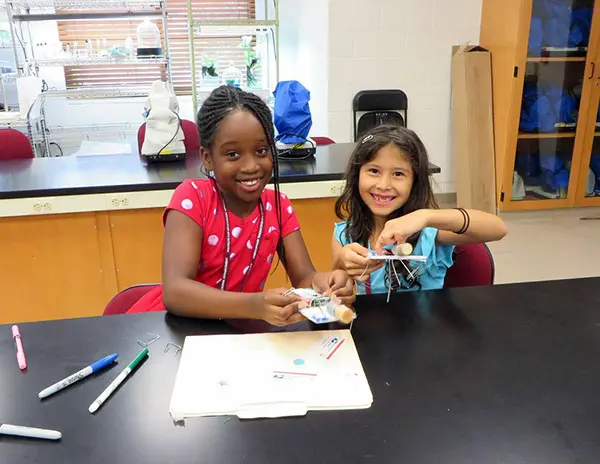The Needs of Gifted Students are Currently Unmet
It is a common misconception that gifted children will naturally perform well in traditional school environments and do not need any help, inside or outside of school.
But that is not the case. Gifted individuals think and learn differently than their peers, and they have needs that extend beyond the academic. Some gifted individuals even have learning disabilities in addition to their high ability. Gifted children need educational accommodations that work with these differences. Unfortunately, the traditional school environment often does not make such accommodations due to the widely-held yet false assumption that gifted students will perform and perform well.
There are more than 3 million gifted students in the United States from all racial, cultural, and socioeconomic backgrounds.¹ Yet an estimated 75% of highly gifted students receive little to no services tailored to their stage and rate of development. The unique needs of this extraordinary population are often unmet, and many of these incredible children are floundering, left to fend for themselves in a world and school environment that does not understand or meet their needs.

Overlooked and Underfunded: Gifted Students in the Classroom
Every child has the right to learn, but the gifted student’s right to learn is currently being ignored and unsupported.
While our efforts to strive for basic proficiency are compelling, students who are already above the bar are left without recognition or support. While we focus on helping our lowest-performing students achieve the bare minimum, we overlook the students who are capable of achieving the extraordinary. At IEA, we believe that we should strive for more than proficiency for our children.
A profoundly gifted child is as far from the norm as is a child with a developmental or intellectual disability. However, while there is a federal mandate for special education for low ability learners, there is no such mandate for high ability learners.2
Funding for GATE programs in schools is consistently being cut, if provided at all. When programs are offered for gifted students in schools, they often take the form of a weekly pull-out program, providing specialized instruction for only a few hours each week. Roughly $70 billion is allocated to schools each year by the U.S. Department of Education; in 2014, $5 million was designated for gifted education.3
Less than 0.01% of our national education budget being used to support 5-7% of the Kindergarten through 12th grade student population.
The majority of the time, gifted learners are expected to learn at the same pace and in the same way as their age-mates. However, these students are not just capable of learning at a faster pace and in greater depth, they need to.
Without optimal learning environments and challenging curricula, studies indicate that many gifted children underachieve, or even drop out of school.
- 88% of student dropouts were receiving passing grades, but dropped out due to boredom. (5)
- Opportunities for real-world learning in school would have significantly improved students’ chances of graduating from high school. (5)
- 82% of gifted underachieving students reversed their underachievement when they had opportunities for strength-based gifted programming. (6)
- Educational interventions fostering talent development among gifted youth result in remarkable, sustained enhancements in lifetime productivity and achievement. (8)
If our high ability youth aren’t challenged in public schools, they need to find enhanced learning experiences somewhere else. IEA provides those experiences, along with the extra tools and focused attention needed to bolster what students are learning in the classroom, in an environment where gifted children are allowed to fully explore who they are.
Citations:
- National Center for Education Statistics, Number of gifted and talented students in public elementary and secondary schools… 2004, https://nces.ed.gov/programs/digest/d07/tables/dt07_050.asp,accessed 11/12/08
- Davidson Institute for Talent Development, IQ and Educational Needs, https://presskit.ditd.org/Davidson_Institute_Press_Kit/ditd_IQ_and_Educational_Needs.html, accessed 1/29/09
- Obama Administration 2014 Budget Prioritizes Key Education Investments to Provide Opportunities for All Americans
https://www.ed.gov/news/press-releases/obama-administration-2014-budget-prioritizes-key-education-investments-provide-o and U.S. Department of Education Awards $3.9 Million to Partnerships to Support Underrepresented Students in Gifted and Talented Programs
https://www.ed.gov/news/press-releases/us-department-education-awards-39-million-partnerships-support-underrepresented– accessed 10/14/14 - Davidson Institute for Talent Development, Characteristics of Intellectually Advanced Young People, https://presskit.ditd.org/Davidson_Institute_Press_Kit/ditd_characteristics.html, accessed 1/29/09
- Bridgeland, John M., et. al., The Silent Epidemic: Perspectives of High School Dropouts (Civic Enterprises for the Bill & Melinda Gates Foundation, 2006)
- Baum, S.M, Renzulli, J.S., and Hebert, T.P, (1999). “Reversing Underachievement: Creative Productivity as a Systematic Intervention”, Gifted Child Quarterly 39, 229-235
- Webb, J., Amend, E.R., Webb, N.E., Goerss, J., Beljan, P., Olenchak, F.R. (2005). Misdiagnosis and Dual Diagnoses of Gifted Children and Adults: ADHD, Bipolar, Ocd, Asperger’s, Depression, and Other Disorders. Great Potential Press.
8. Gross, Miraca U.M., GERRIC, University of New South Wales, presentation at National Association of Gifted Children annual convention, 11/3/06
While gifted children make up 5-7 percent of the total student population, 75 percent of these young people receive little to no services.
The gifted student knows up to 50 percent of the year’s curriculum before the school year even begins.
